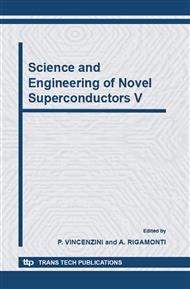p.180
p.188
p.195
p.204
p.212
p.220
p.228
p.238
p.246
Prospects of Application of Superconductivity in Underground Transmission Lines and Levitating Trains
Abstract:
In this article it has been emphasized that superconductivity is only the enabling technology for Super-MAGLEV and the superconducting transmission lines, because all the cost is in cryogenic engineering, electrotechnology and general engineering infrastructure. So if in the long term the hydrogen economy can be combined with superconducting cables and ultra fast trains running in the same vacuum tunnel network, it will be the forerunner to a transportation and energy transfer revolution called SuperTransGrid. In such a system, hydrogen fuel could be provided for energy storage and transfer, very effectively cooling high power superconducting cables, but would also feed low-pollution Cryoplanes and fuel-cell powered cars transporting passengers at speeds ~2000 miles/hour.
Info:
Periodical:
Pages:
246-255
Citation:
Online since:
October 2006
Authors:
Keywords:
Price:
Сopyright:
© 2006 Trans Tech Publications Ltd. All Rights Reserved
Share:
Citation:


